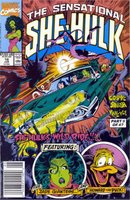 The Cosmic Squish Principle
The Cosmic Squish PrincipleI'm going to TRY to start with a simple plot explanation first. Quite frankly, though, simple is hardly the word I'd use to describe this story!
Picking up from the previous issue, #14 starts with a Critic (a splinter faction of the Watchers) examining a black hole that is literally plungered, creating the "only known trans-dimensional blowhole in the continuum." This spews forth a plethora of small, black boxes that seem to emit magnetic anomolies (the cause of She-Hulk's car breaking down in #13). When Jen reaches her hand into the four-sided box, though, it disappears as it passes through, reappearing in Howard the Duck's refridgerator, much to his surprise.
She-Hulk takes the box to Brent Wilcox, a physics professor she knows, where he explains what it is: "If there are multiple universes, there must be some control principle governing how many and which ones survive. You know -- the way natural selection manages the perpetuation and extinction of species. At least two types of universe would have to be eliminated: those not viable on their own, of course and those which encroach on other universes in a way that threatens the multiversal structure...Now suppose the, ah, 'encorachiverses' never really die. Suppose that like viruses, they can be contained, but not eradicated. The frame could be some natural -- or technological -- or even mystical device -- that keeps them in quarantine and occupying as little space as possible." Got all that?
Now here's the problem. All these encroachiverses were what spewed out of that black hole, and breaking the seal on them allows the encroachiverse to actually encroach on the rest of the universe. Given humans' curiosity, and that all of the boxes got shot to Earth, they'll eventually all be poked and prodded until all of these encroachiverse send the universe into chaos. The Critic decides that he needs a non-indigenous life-form to help set things in order. Enter Howard the Duck.
Howard's unwilling arrival knocks Brent into the box he and Jen were examining. Naturally, She-Hulk dives in afterwards, taking Howard with her. The universe they find themselves in is "the Baloneyverse -- a cosmos of cold cuts" which changes She-Hulk into plain Jen Walters.
That takes readers all the way to the end of #14. Since I'm eager to get into some actual analysis, let me sum up the rest of the story by saying that She-Hulk undergoes several more changes, there are several dues ex machina style rescues from The Critic, we get several such-n-such-verse gags, and it all ends with She-Hulk using the human Black Hole to suck in all the encroachiverses that got spewed out at the beginning of the story.
All of this villainy is actually the work of Dr. Angst, an old Howard the Duck foe who calls himself the Master of Mudane Mysticism. His ultimate goal is to rule the universe. But instead of trying to usurp all of the various worthy leaders, he instead intends to eliminate all but the "dullest places in all of what currently comprises existence." He intends to create the "Insipiverse -- the quintessential distillation of cosmic tedium! A universe of spiritual topor, aesthetic monotony, and intellectual inertia!" His thinking is that a universe so bland would make someone as mundane as himself look brilliant, creative and original thereby making him the most powerful being in the universe. This is, of course, the warped sort of brilliant thinking that Steve Gerber made himself known for while writing Howard the Duck.
Let me start some analysis here by looking at the cover of issue #14. Or, I should say, covers...
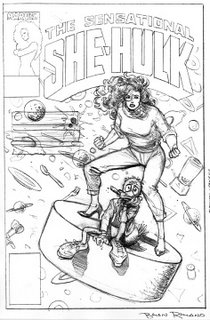
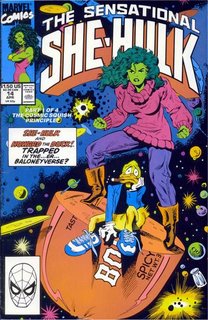
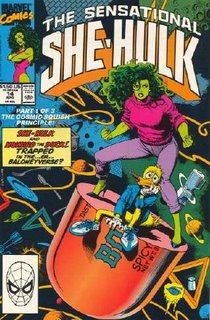
The first one I'm showing here is Brian Bolland's original pencil sketch for the cover. Bolland was something of a hot commodity at the time, and his cover work was a key selling point in the original solicitations. Curiously, however, when the book was published, readers saw that second image, a cover drawn by Mark Texeira. It's virtually an identical image, so clearly Texeira had seen Bolland's work at some point. The third image is Bolland's final cover. This was sent separtely to subscribers and comic shops about a month after #14 came out. It is, in fact, just a cover that is used to promote the Cosmic Squish storyline.
The promo cover says that the Texeira cover was spewed out by one of those "squished" universes, but that clearly didn't happen for real. It seems to me that the Texeira cover was banged out quickly to make a deadline. The color trapping is slap-dashed (not that you can really see that in the scan) and the inking seems rather rushed as well. I can well envision that Bolland faxed his original sketch over to the Marvel offices and -- due to his relative isolation in Great Britain -- was somehow not able to get his final version to them by the time the cover had to go to the printer. In a Stan Lee-ish fashion, someone (perhaps editor Bobbie Chase) grabbed a readily available artist (Texeira) to crank out a finished version of the cover, based on Bolland's fax. Note that some of the more intricate background details like the blender and beaters are absent in Texeira's version.
Now, this has nothing to do with Gerber's writing of course, but I think it's particularly seredipidous that a man who's been writing on this theme of isolation or marginalization has the cover of one of his book's subject to a very real effect of that theme. Bolland's remote location, relative to Marvel, seems to have impacted the very book itself!
Getting to the actual story, there are plenty of instances of physical isolation from society: She-Hulk's physicist friend is thrown into the Baloneyverse by himself; She-Hulk and Howard are dropped into this alien landscape following him; Dr. Angst and his partners/minions are all in positions of social ostricization (Angst himself is in prison, Tillie the Hun works for Hefty Huggable Women's Health Club, the Spanker takes his cues from the solitary Punisher, the Black Hole works as a circus sideshow attraction, and Sitting Bullseye operates in a seemingly remote Survival Course training facility); She-Hulk is at one point sealed in one her cousin's old vaults; The Terror is housed in a nursing home; and The Critic is, by his nature, separated from society.
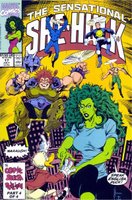 Interestingly, though, there's something of a shift in the theme here. Throughout the story, the encroachiverses start taking up the space formerly occupied by the universe. Rather than erasing that space, however, it is simply compressed to allow for the encroachiverse's existence. What this means is that towards the end of #17, London's Big Ben can be seen from downtown Manhattan. It is a visual represenation of Marshall McLuhan's global village. She-Hulk notes at one point that "we've cross all of Kansas and Missouri in under five minutes" in her flying car. Even more interesting is that She-Hulk's computerized trip meter notes that, when they arrive in London, they've travelled nearly 300,000 miles in the past 6,000 hours despite the impression of having only flown for ten or fifteen minutes. An indication that world is not, in a literal sense, getting smaller, merely that it appears to be getting smaller. It's easier to "commute" virtually from New York to London given the technology at our disposal.
Interestingly, though, there's something of a shift in the theme here. Throughout the story, the encroachiverses start taking up the space formerly occupied by the universe. Rather than erasing that space, however, it is simply compressed to allow for the encroachiverse's existence. What this means is that towards the end of #17, London's Big Ben can be seen from downtown Manhattan. It is a visual represenation of Marshall McLuhan's global village. She-Hulk notes at one point that "we've cross all of Kansas and Missouri in under five minutes" in her flying car. Even more interesting is that She-Hulk's computerized trip meter notes that, when they arrive in London, they've travelled nearly 300,000 miles in the past 6,000 hours despite the impression of having only flown for ten or fifteen minutes. An indication that world is not, in a literal sense, getting smaller, merely that it appears to be getting smaller. It's easier to "commute" virtually from New York to London given the technology at our disposal. Further, McLuhan wrote that "unless aware of this dynamic, we shall at once move into a phase of panic terrors, exactly befitting a small world of tribal drums, total interdependence, and superimposed co-existence." And indeed, we see here that most of the characters run around in terror (possibly the reason Gerber saw fit to include the character The Terror) of the superimposed co-existence of the multiple universes until they finally realize what is happening. It is only in the last few pages of the story in which they divine the actual threat and, working together, beat the villains. It is also interesting to note that The Terror becomes mysteriously absent just as She-Hulk takes advantage of the relative proximity of Big Ben during her fight with Tillie. A physical representation of the panic terrors receeding with cognition of the situation?
The question then arises, if She-Hulk is indeed to be considered part of Gerber's Defenders storyline, does this in fact really fit thematically with everything that preceeded it? I say, "Absolutely."
With "The Cosmic Squish Principle," we see Gerber continuing his theme of individuals working on fringes of society. The protagonists largely work in relative isolation, and are only drawn together to defeat the greater threat. But extending that theme, Gerber seems to be saying that the global village allows us to reach out beyond our normal geographic confines to seek aid. At the beginning of the story, She-Hulk and Weezi were in Vermont, Howard was in Cleveland, Brent was in New York, and The Critic was "at the fringes of the galaxy, in the vicinity of the Magellanic Cloud." By the end of the story, they've all met and worked together, thanks to the various technologies available to them -- only to go their separate ways again on the very last page.
It would seem that Gerber, in the years between his original Defenders work and 1990 when he took over Sensational She-Hulk, found that technology can be used to overcome some of the societal marginalization that occurs for many people. That we are still individuals and occasionally find ourselves pushed to the fringes of society, but that we can utilize the technology at hand to find others who have also been pushed to those same fringes. Although technology breeds specialization which can breed feelings of isolation, that same technology can also be used to bring together the specialists to form a loose society in and of itself.
This theme is even more directly addressed in Gerber's final She-Hulk stories, and I'll address those in tomorrow's blog.






3 comments:
And let us not overlook the way Alan Moore may have borrowed an idea or two from this for the conclusion of Promethea:
"...London's Big Ben can be seen from downtown Manhattan..."
Hmmmmm.
Oh, well, if you want to bring Moore into it, that's a whole 'nother set of blogs! :)
So that makes TWO and counting Moore borrowings from Gerber. I knew my fellow ex-pats were soft on Gerber but it's interesting to see it at work.
Post a Comment